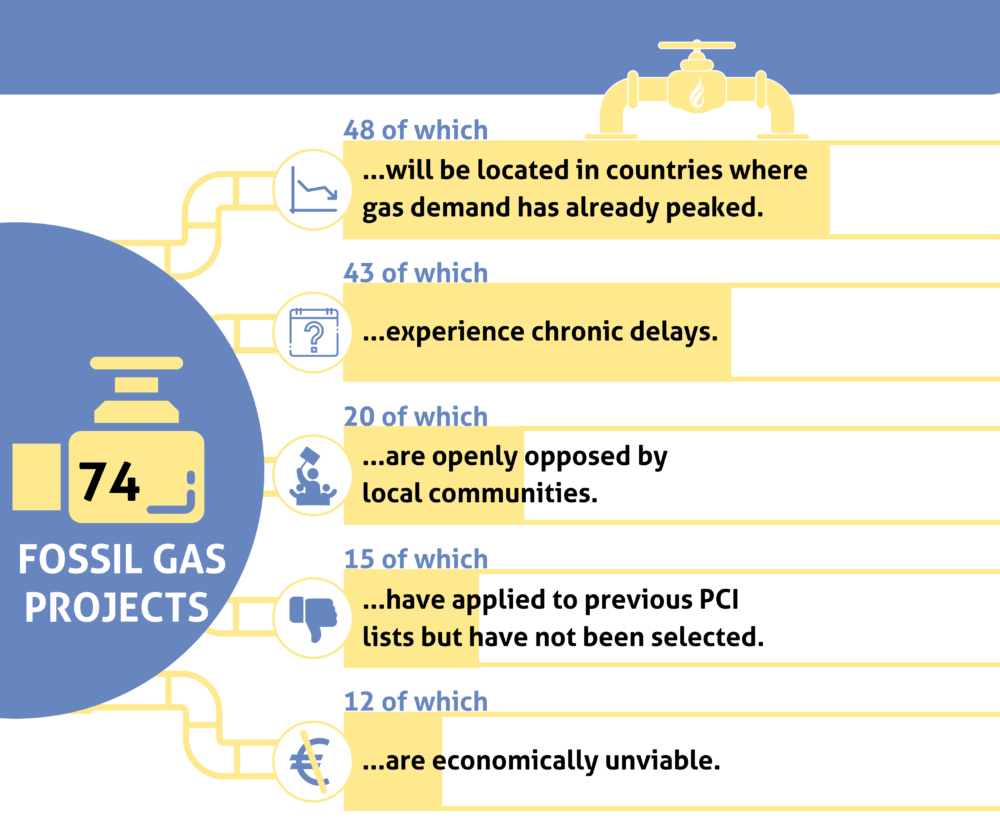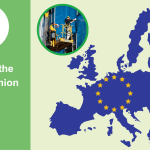In January 2021, the European Commission published a list of candidate projects for the 5th list of Projects of Common Interest, or PCIs. PCIs are cross-border energy infrastructure projects which receive the highest political support at EU level: faster permitting procedures, streamlined environmental impact assessments and eligibility for a dedicated line of EU funding (the Connecting Europe Facility, or CEF).
74 fossil gas infrastructure projects have applied and are eager to receive the PCI label. None of them should be selected, for a variety of reasons.
What is wrong with the new gas infrastructure?
Fossil gas is a climate-polluting fuel. In Europe, it is already responsible for more CO2 emissions than coal. The production, transport and use of fossil gas is also inevitably linked to dangerous and significantly underreported emissions of methane, a greenhouse gas which is responsible for nearly 25% of global warming observed today and hence makes tackling fossil gas an important element of any actions that address the climate urgency.
Accordingly, building new fossil gas infrastructure is simply incompatible with Europe’s commitment to reach climate neutrality by 2050, and even less by 2040, which is what is needed to limit temperature increase to 1.5°C and be in line with the Paris Agreement. It is also unnecessary and economically unviable: all credible scenarios, including the European Commission’s projections in line with its 55% emissions reduction target, would translate into a decrease in fossil gas demand between 32% and 37% in 2030 -and beyond. New fossil gas infrastructure would therefore result in stranded assets and a waste of taxpayers’ money to be borne by citizens.
Against this background, giving fossil gas projects access to a dedicated line of public funding and to regulatory fast lanes seems incoherent and absurd. And yet this is what will happen if fossil gas projects will get a seat on the 5th PCI list.
Selecting candidate fossil gas projects would also be incoherent with the revised regulation on Trans-European Energy Infrastructure (TEN-E), which will most likely come into force in 2022 and excludes at this stage all “classic” fossil gas projects. The 5th PCI list, on the other hand, will also be adopted in 2022 but would still foresee the construction of fossil gas infrastructure. This would result in a situation of stark policy incoherence under which a fossil gas infrastructure-free regulation (TEN-E) is in place, while at the same time fossil gas projects would still receive fast-lane treatments and be
eligible for EU funding up to 2023.
Around two thirds of the fossil gas candidate projects’ PCI fiches mention the possibility for the infrastructure project to carry hydrogen in the future. While there might at some point be limited use in repurposing a very low number of existing gas pipelines to carry renewable hydrogen, it is concerning that the argument of future use for hydrogen is used for fossil gas infrastructure that is not even built today and that would come on top of an already oversized gas grid. The debate of possible hydrogen readiness must not cover up the risk of creating stranded assets with the build-out of the EU’s gas grid, and it must not distract from a need to decommission gas infrastructure.
There is no way around it: including fossil gas infrastructure in the 5th PCI list means perpetuating support of an energy infrastructure that will be incompatible with the EU’s own vision of a future-proof energy system.
What is wrong with these 74 candidate projects?
There are 74 [1] fossil gas projects among the candidates for the 5th PCI list. As all of them represent additional fossil gas infrastructure on top of the existing dense and costly EU gas grid, they are incompatible with EU’s climate goals. As a recent report by Artelys shows, Europe does not need any fossil gas projects to address energy security needs. On top of that, these specific candidate fossil gas projects should not be included in the 5th PCI list for at least one of the following reasons:
- They have applied to previous PCI lists but have not been selected. Fifteen of the candidate projects – including mammoth pipeline projects like the Eastring, the White Stream and the enlargement of the BRUA pipeline – have applied to become PCIs in the past but have been rejected by the European Commission. There is no reason why they should be worth any consideration in 2021, especially in light of the EU’s increased climate ambition.
- They are economically unviable without public funding. Twelve of the candidate projects have already received millions of euros for construction works from the Connecting Europe Facility, which grants this type of funding only for projects that “are not commercially viable and would normally not make it into investment programmes of infrastructure developers”. These harmful projects are not only incompatible with climate targets but they need public funding to make economic sense. Among them are the LNG terminal in Cyprus, the GIPL pipeline between Poland and Lithuania and the Baltic Pipe between Denmark and Poland. There is no point in wasting already scarce public money on polluting, economically unviable projects. Instead, EU funding and support should benefit a truly sustainable, just energy transition. Recent research shows this has already happened in the past, with €440 million being directed towards fossil gas projects which were not completed or are still not used.
- They experience chronic delays. A striking 65% of all projects that were already part of the 4th PCI lists (43 out of 66) have seen their commissioning date delayed by at least one year – oftentimes even longer. In Greece, for example, two pipelines – the IGB project, connecting Greece to Bulgaria, and the Poseidon pipeline, connecting it to Italy – have already seen their commissioning date postponed by 5 years. In 2020 only two gas projects part of the 4th list of PCIs have advanced compared to 2019. According to ACER, the most frequent reasons behind the delays are financing difficulties. Every year of delay confirms the economic unviability of these projects and increases the likelihood of incurring into stranded assets.
- They will be located in countries where gas demand has already peaked. With only three exceptions, all EU countries where the candidate projects will be located already experienced a peak in gas demand in the past decade. In all circumstances, existing fossil gas infrastructure was enough to satisfy and manage the demand during peak years, another reason not to build new, additional gas infrastructure in these countries. This is especially the case considering that gas demand has dropped in 16 member states by at least 10% in 2019 compared to respective peak years. Those countries include France, Hungary, Italy, Lithuania, Latvia, Romania, Slovakia Denmark, Bulgaria and Slovenia, all of which have PCI candidate projects on their territory.
- They are openly opposed by local communities. Twenty of the candidate projects are facing some form of local opposition from the same communities that are supposed to benefit from them. A fierce opposition – driven by environmental, health and geopolitical concerns – has grown towards several projects which would increase fossil gas imports from outside the EU. These include the LNG terminals in Krk (Croatia) and Skulte (Latvia), but also the construction or extension of gigantic pipelines: TANAP, TAP, South Caucasus and Trans-Caspian pipelines, as well as the EastMed, connecting European mainland to the gas fields in the contested waters of South-East Mediterranean. Even if they manage to see the light of day (in many years from now) all these mega-projects will be unnecessary in a continent where gas demand is set to decrease.

The PCIs legislative process
Every two years, the European Commission adopts a new list of PCIs in the form of a delegated act. The European Parliament and the Council of the EU have two months (with the possibility of a prolongation of another 2 months) to adopt or oppose the
entire list, including all PCIs from all categories. The publication of a final draft 5th list of PCIs is expected by late 2021. The process to select which projects will be included has already started in January, with the publication of a new list of candidates. Before being adopted by the European Commission, it will be discussed during Spring and Summer 2021 in Regional Groups – a platform heavily influenced by electricity and transmission system operators.
Sign the petition here!



